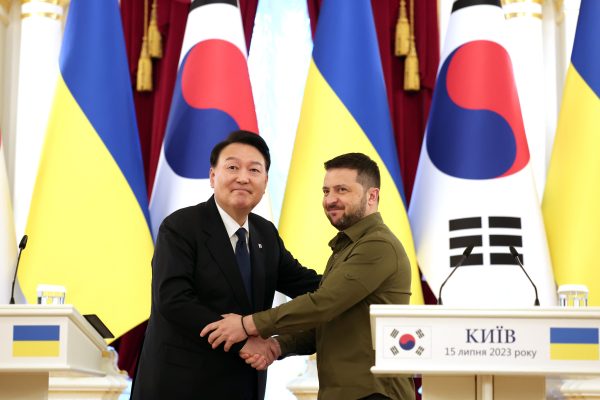President Joe Biden emphasized NATO’s commitment to bolstering transatlantic deterrence and maintaining a lasting shield against aggression as he met with his alliance counterparts today in Washington.
NATO’s strength, the president said, is the product of continued investment among allies — including U.S. investments to double the number of battle groups on NATO’s eastern flank in recent years.
He added that 23 NATO allies currently spend at or above the minimum 2% of gross domestic product on defense spending, which is more than two times the number who met the benchmark as recently as 2021.
“For 75 years, our nations have grown and prospered behind the NATO shield,” Biden said. “Today, we’re stronger than we’ve ever been.”
The leaders met as part of the three-day NATO Summit in Washington, where they laid out additional steps to continue to bolster NATO’s strength through key investments in its defense industrial base.
Those investments include an increase in defense industrial production and a pledge to coordinate national plans to strengthen industrial capacity.
“For the first time ever, every NATO nation is pledging to develop plans for defense production at home,” Biden said. “That means the alliance will become more innovative and competitive.”
He said these investments are critical to maintaining deterrence as Russia continues its war in Ukraine.
“Right now, Russia is on a wartime footing with regard to defense production,” Biden said. “They’re significantly ramping up their production of weapons, munitions and vehicles. And they’re doing it with the help of China, North Korea and Iran.
“We cannot allow the alliance to fall behind,” he added.
The president said the pledge serves as a strong message that every NATO member remains committed to further strengthening the alliance.
“We can and will defend every inch of NATO territory,” he said. “And we’ll do it together.”
The allies’ pledged investments in the defense industrial base are part of a broader list of summit outcomes to strengthen the alliance.
NATO Secretary General Jens Stoltenberg detailed those outcomes during a news conference today after the meeting among the allies.
Those include steps to advance NATO’s modernized command structure and put a new generation of defense plans into practice.
The latest plans, which were agreed to at last year’s summit in Vilnius, Lithuania, are the first comprehensive defense blueprint developed by the alliance since the end of the Cold War.
They include an updated force structure to strengthen NATO’s ability to respond to any scenario and across all domains.
The allies have also pledged to expand partnerships with key allies in the Indo-Pacific. This year’s summit includes high-level meetings with key partners in the region, including Australia, Japan, New Zealand and South Korea.
The leaders also announced significant steps to further support Ukraine’s defense against Russian aggression, as well as Ukraine’s long-term bridge to membership in the alliance.
Those steps include the standup of the NATO Security Assistance and Training for Ukraine, or NSATU, initiative which will coordinate equipment, training and force development for Ukraine as it advances on its path to full interoperability with NATO.
The effort will be based in Germany and carried out in countries throughout the alliance.
“The work we are doing together now will ensure that when the time is right, Ukraine can join [the alliance] without delay,” Stoltenberg said. “It is not a question of if, but when.”
NATO leaders also agreed to a baseline of $43 billion (40 billion euros) of security assistance to Ukraine within the next year.
“We are not doing this because we want to prolong a war,” Stoltenberg said. “We are doing this because we want to end the war as soon as possible. The quickest way to end the war is to lose the war, but that would not bring peace. It will only bring occupation.
“So, unless we want Ukraine to lose, unless we want to bow to Putin, we need to show commitment and resolve,” he said.





















Discussion about this post